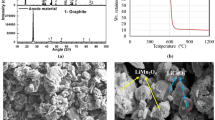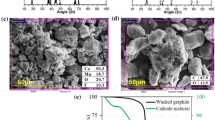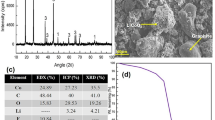Abstract
The unprecedented increase in mobile phone spent lithium-ion batteries (LIBs) in recent times has become a major concern for the global community. The focus of current research is the development of recycling systems for LIBs, but one key area that has not been given enough attention is the use of pre-treatment steps to increase overall recovery. A mechanical process combined with gravity, magnetic separation, and flotation was developed to recover metals and plastics. The results of the enrichment experiments in the coarse fraction showed that plastics with natural hydrophobicity could be obtained by reverse flotation. In the presence of hydrogen peroxide, sulfuric acid leaching was subjected to the black mass for recovering Li, Co, Ni, and Mn. The dissolution conditions were optimized by changing leaching parameters. The dissolution efficiencies of 96% Co, 94% Ni, 95% Mn, and 98% Li were achieved with 2 M H2SO4 concentration, 60 °C temperature, 2 h leaching time, and 40 g/L H2O2 dosage. In the precipitation step, NaOH was added to the leachate to increase the pH, and Co and Ni were partially separated from Mn at pH 7.7. The proposed flowsheet is basic and highly effective for the complementary recycling of components in Li-ion batteries.












Similar content being viewed by others
Data availability
The authors confirm that the data supporting the findings of this study are available at https://doi.org/10.1007/s10163-023-01652-5.
References
Kaya M (2022) State-of-the-art lithium-ion battery recycling technologies. Circ Econ 1:100015. https://doi.org/10.1016/j.cec.2022.100015
Ebin B, Petranikova M, Ekberg C (2018) Physical separation, mechanical enrichment and recycling-oriented characterization of spent NiMH batteries. J Mater Cycles Waste Manag 20:2018–2027. https://doi.org/10.1007/s10163-018-0751-4
Chen X, Ma H, Luo C, Zhou T (2017) Recovery of valuable metals from waste cathode materials of spent lithium-ion batteries using mild phosphoric acid. J Hazard Mater 326:77–86. https://doi.org/10.1016/j.jhazmat.2016.12.021
Celep O, Yazıcı EY, Deveci H, Dorfling C (2022) Recovery of lithium, cobalt and other metals from lithium-ion batteries. Pamukkale Univ J Eng Sci. https://doi.org/10.5505/pajes.2022.98793
Grey CP, Tarascon JM (2017) Sustainability and in situ monitoring in battery development. Nat Mater 16:45–56. https://doi.org/10.1038/nmat4777
Choubey PK, Chung K, Kim M, Lee J, Srivastava RR (2017) Advance review on the exploitation of the prominent energy-storage element Lithium. Part II: From sea water and spent lithium ion batteries (LIBs). Miner Eng 110:104–121. https://doi.org/10.1016/j.mineng.2017.04.008
Lv W, Wang Z, Cao H, Sun Y, Zhang Y, Sun Z (2018) A critical review and analysis on the recycling of spent lithium-ion batteries. ACS Sustain Chem Eng 6:1504–1521. https://doi.org/10.1021/acssuschemeng.7b03811
Billy E, Joulié M, Laucournet R et al (2018) Dissolution mechanisms of LiNi1/3Mn1/3Co1/3O2 positive electrode material from lithium-ion batteries in acid solution. ACS Appl Mater Interfaces 10:16424–16435. https://doi.org/10.1021/acsami.8b01352
Zhang T, He Y, Ge L et al (2013) Characteristics of wet and dry crushing methods in the recycling process of spent lithium-ion batteries. J Power Sources 240:766–771. https://doi.org/10.1016/j.jpowsour.2013.05.009
He Y, Yuan X, Zhang G et al (2021) A critical review of current technologies for the liberation of electrode materials from foils in the recycling process of spent lithium-ion batteries. Sci Total Environ 766:142382. https://doi.org/10.1016/j.scitotenv.2020.142382
Takacova Z, Havlik T, Kukurugya F, Orac D (2016) Cobalt and lithium recovery from active mass of spent Li-ion batteries: theoretical and experimental approach. Hydrometallurgy 163:9–17. https://doi.org/10.1016/j.hydromet.2016.03.007
Wang X, Gaustad G, Babbitt CW (2016) Targeting high value metals in lithium-ion battery recycling via shredding and size-based separation. Waste Manag 51:204–213. https://doi.org/10.1016/j.wasman.2015.10.026
Khoo HH (2009) Life cycle impact assessment of various waste conversion technologies. Waste Manag 29:1892–1900. https://doi.org/10.1016/j.wasman.2008.12.020
Zhang X, Xie Y, Lin X et al (2013) An overview on the processes and technologies for recycling cathodic active materials from spent lithium-ion batteries. J Mater Cycles Waste Manag 15:420–430. https://doi.org/10.1007/s10163-013-0140-y
Wang F, Zhang T, He Y et al (2018) Recovery of valuable materials from spent lithium-ion batteries by mechanical separation and thermal treatment. J Clean Prod 185:646–652. https://doi.org/10.1016/j.jclepro.2018.03.069
Liu C, Lin J, Cao H et al (2019) Recycling of spent lithium-ion batteries in view of lithium recovery: a critical review. J Clean Prod 228:801–813. https://doi.org/10.1016/j.jclepro.2019.04.304
Burat F, Baştürkcü H, Özer M (2019) Gold&silver recovery from jewelry waste with combination of physical and physicochemical methods. Waste Manag 89:10–20. https://doi.org/10.1016/j.wasman.2019.03.062
Dinç Nİ, Tosun AU, Baştürkcü E, Özer M, Burat F (2022) Recovery of valuable metals from WPCB fines by centrifugal gravity separation and froth flotation. J Mater Cycles Waste Manag 24:224–236. https://doi.org/10.1007/s10163-021-01310-8
Sommerville R, Zhu P, Rajaeifar MA, Heidrich O, Goodship V, Kendrick E (2021) A qualitative assessment of lithium ion battery recycling processes. Resour Conserv Recycl 165:105219. https://doi.org/10.1016/j.resconrec.2020.105219
Tanısalı E, Özer M, Burat F (2020) Precious metals recovery from waste printed circuit boards by gravity separation and leaching. Miner Process Extr 42:24–37. https://doi.org/10.1080/08827508.2020.1795849
Zhang G, He Y, Wang H, Feng Y, Xie W, Zhu X (2019) Application of mechanical crushing combined with pyrolysis-enhanced flotation technology to recover graphite and LiCoO2 from spent lithium-ion batteries. J Clean Prod 231:1418–1427. https://doi.org/10.1016/j.jclepro.2019.04.279
Güney A, Özdilek C, Kangal MO, Burat F (2015) Flotation characterization of PET and PVC in the presence of different plasticizers. Sep Purif Technol 151:47–56. https://doi.org/10.1016/j.seppur.2015.07.027
Vanderbruggen A, Salces A, Ferreira A et al (2022) Improving separation efficiency in end-of-life lithium-ion batteries flotation using attrition pre-treatment. Minerals 12:72. https://doi.org/10.3390/min12010072
Yenial Ü, Burat F, Yüce AE et al (2013) Separation of PET and PVC by flotation technique without using alkaline treatment. Miner Process Extr 34:412–421. https://doi.org/10.1080/08827508.2012.702705
Meshram P, Mishra A, Abhilash SR (2020) Environmental impact of spent lithium ion batteries and green recycling perspectives by organic acids—a review. Chemosphere 242:125291. https://doi.org/10.1016/j.chemosphere.2019.125291
Prasetyo E, Muryanta WA, Anggraini AG, Sudibyo S, Amin M, Muttaqii MA (2022) Tannic acid as a novel and green leaching reagent for cobalt and lithium recycling from spent lithium-ion batteries. J Mater Cycles Waste Manag 24:927–938. https://doi.org/10.1007/s10163-022-01368-y
Contestabile M, Panero S, Scrosati B (2001) A laboratory-scale lithium-ion battery recycling process. J Power Sources 92:65–69. https://doi.org/10.1016/S0378-7753(00)00523-1
Zhang P, Yokoyama T, Itabashi O, Suzuki TM, Inoue K (1998) Hydrometallurgical process for recovery of metal values from spent lithium-ion secondary batteries. Hydrometallurgy 47:259–271. https://doi.org/10.1016/S0304-386X(97)00050-9
Shin SM, Kim NH, Sohn JS, Yang DH, Kim YH (2005) Development of a metal recovery process from Li-ion battery wastes. Hydrometallurgy 79:172–181. https://doi.org/10.1016/j.hydromet.2005.06.004
Aktas S, Fray DJ, Burheim O, Fenstad J, Açma E (2006) Recovery of metallic values from spent Li ion secondary batteries. Trans Inst Min Metallur Sect C Miner Process Extr 115:95–100. https://doi.org/10.1179/174328506X109040
Dorella G, Mansur MB (2007) A study of the separation of cobalt from spent Li-ion battery residues. J Power Sources 170:210–215. https://doi.org/10.1016/j.jpowsour.2007.04.025
Swain B, Jeong J, Lee JC, Lee GH, Sohn JS (2007) Hydrometallurgical process for recovery of cobalt from waste cathodic active material generated during manufacturing of lithium ion batteries. J Power Sources 167:536–544. https://doi.org/10.1016/j.jpowsour.2007.02.046
Lee CK, Rhee K-I (2003) Reductive leaching of cathodic active materials from lithium ion battery wastes. Hydrometallurgy 68:5–10. https://doi.org/10.1016/S0304-386X(02)00167-6
Li L, Ge J, Wu F, Chen R, Chen S, Wu B (2010) Recovery of cobalt and lithium from spent lithium ion batteries using organic citric acid as leachant. J Hazard Mater 176:288–293. https://doi.org/10.1016/j.jhazmat.2009.11.026
Li L, Ge J, Chen R, Wu F, Chen S, Zhang X (2010) Environmental friendly leaching reagent for cobalt and lithium recovery from spent lithium-ion batteries. Waste Manag 30:2615–2621. https://doi.org/10.1016/j.wasman.2010.08.008
de Oliveira DJ, Stefanello Cadore J, da Silveira de Oliveira F, Tanabe EH, Bertuol DA (2019) Recovery of metals from spent lithium-ion batteries using organic acids. Hydrometallurgy 190:105169. https://doi.org/10.1016/j.hydromet.2019.105169
Chen WS, Ho HJ (2018) Recovery of valuable metals from lithium-ion batteries NMC cathode waste materials by hydrometallurgical methods. Metals 8:321. https://doi.org/10.3390/met8050321
Takahashi VCI, Botelho Junior AB, Espinosa DCR, Tenório JAS (2020) Enhancing cobalt recovery from Li-ion batteries using grinding treatment prior to the leaching and solvent extraction process. J Environ Chem Eng 8:103801. https://doi.org/10.1016/j.jece.2020.103801
Meshram P, Pandey BD, Mankhand TR (2015) Hydrometallurgical processing of spent lithium ion batteries (LIBs) in the presence of a reducing agent with emphasis on kinetics of leaching. J Chem Eng 281:418–427. https://doi.org/10.1016/j.cej.2015.06.071
Swain B (2017) Recovery and recycling of lithium: A review. Sep Purif Technol 172:388–403. https://doi.org/10.1016/j.seppur.2016.08.031
Chen X, Xu B, Zhou T, Liu D, Hu H, Fan S (2015) Separation and recovery of metal values from leaching liquor of mixed-type of spent lithium-ion batteries. Sep Purif Technol 144:197–205. https://doi.org/10.1016/j.seppur.2015.02.006
Pant D, Dolker T (2017) Green and facile method for the recovery of spent Lithium Nickel Manganese Cobalt Oxide (NMC) based Lithium ion batteries. Waste Manag 60:689–695. https://doi.org/10.1016/j.wasman.2016.09.039
Nan J, Han D, Zuo X (2005) Recovery of metal values from spent lithium-ion batteries with chemical deposition and solvent extraction. J Power Sources 152:278–284. https://doi.org/10.1016/j.jpowsour.2005.03.134
Wang HY, Huang K, Zhang Y, Chen X, Jin W, Zheng SL, Zhang Y, Li P (2017) Recovery of lithium, nickel, and cobalt from spent lithium-ion battery powders by selective ammonia leaching and an adsorption separation system. ACS Sustain Chem Eng 5:11489–11495. https://doi.org/10.1021/acssuschemeng.7b02700
Zhang W, Cheng CY (2007) Manganese metallurgy review. Part II: Manganese separation and recovery from solution. Hydrometallurgy 89:160–177. https://doi.org/10.1016/j.hydromet.2007.08.009
Chagnes A, Pospiech B (2013) A brief review on hydrometallurgical technologies for recycling spent lithium-ion batteries. J Chem Technol Biotechnol 88:1191–1199. https://doi.org/10.1002/jctb.4053
Mennik F, Dinç Nİ, Burat F (2023) Selective recovery of metals from spent mobile phone lithium-ion batteries through froth flotation followed by magnetic separation procedure. Results Eng 17:100868. https://doi.org/10.1016/j.rineng.2022.100868
Burat F, Demirağ A, Şafak MC (2020) Recovery of noble metals from floor sweeping jewelry waste by flotation-cyanide leaching. J Mater Cycles Waste Manag 22:907–915. https://doi.org/10.1007/s10163-020-00982-y
Fadel MA, Kamel NA, Darwish MM, El-Messieh SL, Abd-El-Nour K, Khalil WA (2020) Preparation and characterization of polyethylene terephthalate–chamomile oil blends with enhanced hydrophilicity and anticoagulant properties. Prog Biomater 9:97–106. https://doi.org/10.1007/s40204-020-00133-4
Saneie R, Abdollahi H, Ghassa S, Azizi D, Chelgani SC (2022) Recovery of copper and aluminum from spent lithium-ion batteries by froth flotation: a sustainable approach. J Sustain Metall 8:386–397. https://doi.org/10.1007/s40831-022-00493-0
He LP, Sun SY, Mu YY, Song XF, Yu JG (2017) Recovery of lithium, nickel, cobalt, and manganese from spent lithium-ion batteries using l-tartaric acid as a leachant. ACS Sustain Chem Eng 5:714–721. https://doi.org/10.1021/acssuschemeng.6b02056
Pinna EG, Toro N, Gallegos S, Rodriguez MH (2022) A novel recycling route for spent li-ion batteries. Materials 15:44. https://doi.org/10.3390/ma15010044
Kang J, Senanayake G, Sohn J, Shin SM (2010) Recovery of cobalt sulfate from spent lithium ion batteries by reductive leaching and solvent extraction with Cyanex 272. Hydrometallurgy 100:168–171. https://doi.org/10.1016/j.hydromet.2009.10.010
Lain MJ (2001) Recycling of lithium ion cells and batteries. J Power Sources 97–98:736–738. https://doi.org/10.1016/S0378-7753(01)00600-0
Lee CK, Rhee K-I (2002) Preparation of LiCoO2 from spent lithium-ion batteries. J Power Sources 109:17–21. https://doi.org/10.1016/S0378-7753(02)00037-X
Guimarães LF, Botelho Junior AB, Espinosa DCR (2022) Sulfuric acid leaching of metals from waste Li-ion batteries without using reducing agent. Miner Eng 183:107597. https://doi.org/10.1016/j.mineng.2022.107597
Acknowledgements
The present study is based on the results of the graduate and undergraduate thesis conducted at Istanbul Technical University. The authors sincerely thank the Mineral Processing Department of Istanbul Technical University for providing laboratory equipment and analysis for this research. We would like to thank Exitcom Recycling Co. for supplying the S-LIB samples. We are grateful to Rantek Co. for their support in crushing battery samples to fine size by cutting mill.
Author information
Authors and Affiliations
Contributions
FM, NİD, İEÇ, and FB contributed to the investigation, methodology, and experimental design. FB and AG are involved in supervision, validation, writing-original draft, review, and editing.
Corresponding author
Ethics declarations
Conflict of interest
On behalf of all authors, the corresponding author states that there is no conflict of interest.
Additional information
Publisher's Note
Springer Nature remains neutral with regard to jurisdictional claims in published maps and institutional affiliations.
Rights and permissions
Springer Nature or its licensor (e.g. a society or other partner) holds exclusive rights to this article under a publishing agreement with the author(s) or other rightsholder(s); author self-archiving of the accepted manuscript version of this article is solely governed by the terms of such publishing agreement and applicable law.
About this article
Cite this article
Çuhadar, İ.E., Mennik, F., Dinç, N.İ. et al. Characterization and recycling of lithium nickel manganese cobalt oxide type spent mobile phone batteries based on mineral processing technology. J Mater Cycles Waste Manag 25, 1746–1759 (2023). https://doi.org/10.1007/s10163-023-01652-5
Received:
Accepted:
Published:
Issue Date:
DOI: https://doi.org/10.1007/s10163-023-01652-5




